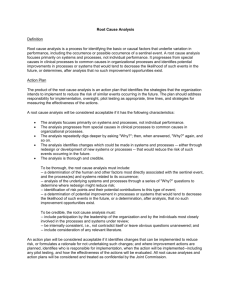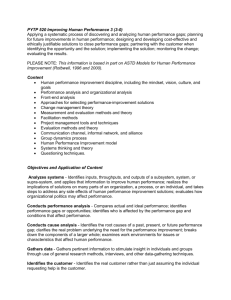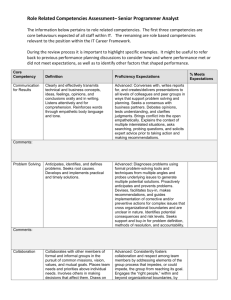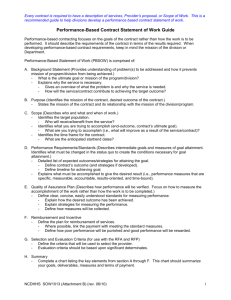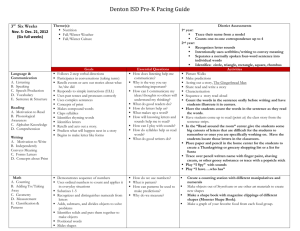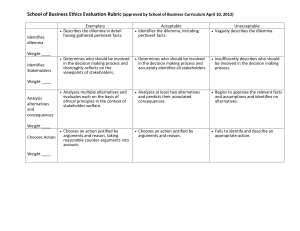10392 Explain nutrition principles for beauty services
advertisement
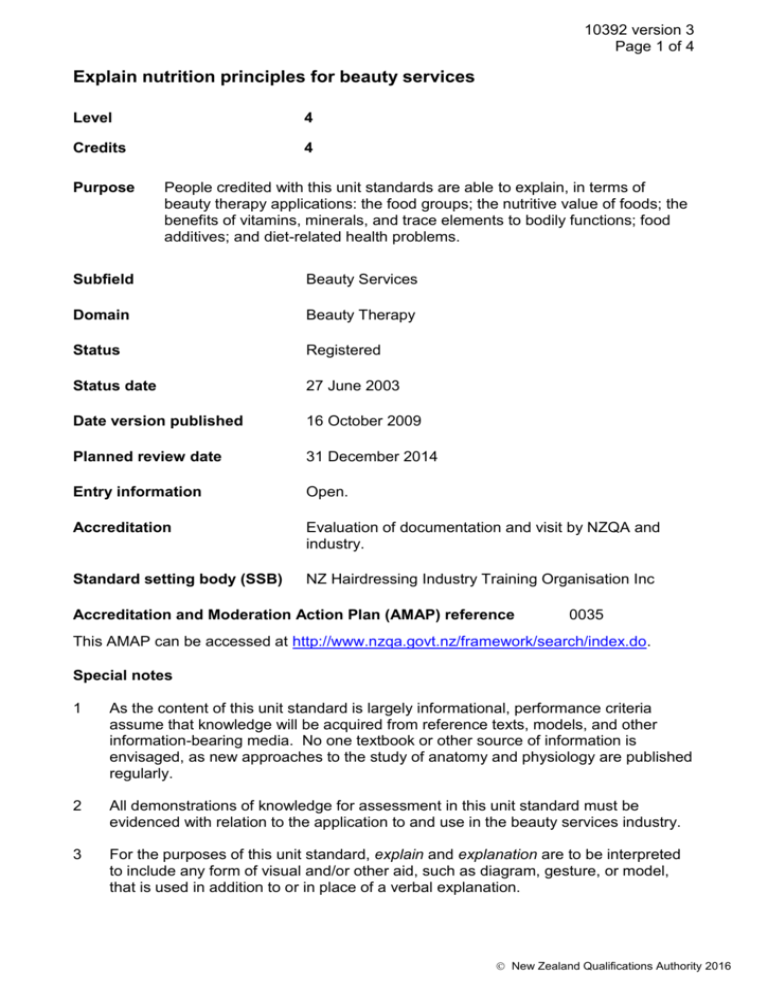
10392 version 3 Page 1 of 4 Explain nutrition principles for beauty services Level 4 Credits 4 Purpose People credited with this unit standards are able to explain, in terms of beauty therapy applications: the food groups; the nutritive value of foods; the benefits of vitamins, minerals, and trace elements to bodily functions; food additives; and diet-related health problems. Subfield Beauty Services Domain Beauty Therapy Status Registered Status date 27 June 2003 Date version published 16 October 2009 Planned review date 31 December 2014 Entry information Open. Accreditation Evaluation of documentation and visit by NZQA and industry. Standard setting body (SSB) NZ Hairdressing Industry Training Organisation Inc Accreditation and Moderation Action Plan (AMAP) reference 0035 This AMAP can be accessed at http://www.nzqa.govt.nz/framework/search/index.do. Special notes 1 As the content of this unit standard is largely informational, performance criteria assume that knowledge will be acquired from reference texts, models, and other information-bearing media. No one textbook or other source of information is envisaged, as new approaches to the study of anatomy and physiology are published regularly. 2 All demonstrations of knowledge for assessment in this unit standard must be evidenced with relation to the application to and use in the beauty services industry. 3 For the purposes of this unit standard, explain and explanation are to be interpreted to include any form of visual and/or other aid, such as diagram, gesture, or model, that is used in addition to or in place of a verbal explanation. New Zealand Qualifications Authority 2016 10392 version 3 Page 2 of 4 4 In this unit standard, all ranges identify the minimum that is critical for assessment. A wider scope may nevertheless be taught. 5 The focus of this unit standard is the anatomy and physiology of human systems that are healthy and functioning properly. Diseases and disorders are included only where appropriate to the professional competence of a beauty practitioner. Elements and performance criteria Element 1 Explain the food groups. Range protein (animal, plant), carbohydrate (simple, complex), fats (saturated, unsaturated). Performance criteria 1.1 Explanation identifies the food groups and their general functions in the body. 1.2 Explanation identifies the balance of food groups in the food pyramid. Element 2 Explain the nutritive value of foods. Performance criteria 2.1 Explanation identifies the main food sources of nutrients. Range protein (both animal and plant), simple and complex carbohydrates, dietary fibre, saturated fats, poly-unsaturated fats, mono-unsaturated fats. 2.2 Explanation identifies the different nutritional values of animal and plant protein. 2.3 Explanation identifies the role of lipids in the body. Range fatty acids, triglycerides, essential fatty acids, phospholipids, sterols. 2.4 Explanation identifies the difference between nutritional energy and expended physical energy. 2.5 The units of energy are identified and the numerical conversion demonstrated. Range kilojoules, calories. 2.6 Explanation identifies the factors affecting basal metabolic rate. 2.7 Explanation identifies the balance of water intake and fluid loss. New Zealand Qualifications Authority 2016 10392 version 3 Page 3 of 4 Element 3 Explain the benefits of vitamins, minerals, and trace elements to bodily functions. Performance criteria 3.1 The vitamins, major minerals, and trace elements essential to maintain a balanced nutritional intake are identified. Range vitamins – A, B complex group, C, D, E, F, K, P; minerals – calcium, phosphorus, sulphur, potassium, sodium chloride, magnesium, iron; trace elements – fluoride, zinc, copper, iodine, manganese, cobalt, chromium. 3.2 Explanation identifies the difference between fat soluble and water soluble vitamins. 3.3 Explanation identifies the major food sources of selected vitamins and minerals. Range 3.4 vitamins – A, B complex, C, D, E, K, P; minerals – iron, calcium, phosphorus, magnesium, sodium chloride, potassium; trace elements – iodine, zinc, copper, chromium, manganese. Explanation identifies the effects of deficiency and the implications of overdose, of vitamins and minerals as food supplements. Element 4 Explain food additives. Performance criteria 4.1 Explanation identifies the purpose and common categories of food additives. Range 4.2 preservatives, antioxidants, food conditioners, flavouring substances, food colouring. Explanation compares the benefits and hazards of the use of food additives. Element 5 Explain diet-related health problems. Performance criteria 5.1 Explanation identifies the health risks associated with diets high in fats, salt, and sugar, and low in dietary fibre. New Zealand Qualifications Authority 2016 10392 version 3 Page 4 of 4 5.2 Explanation identifies the dietary factors contributing to osteoporosis and iron deficiency anaemia. 5.3 Explanation identifies the effects and health implications of weight reduction dietary programmes. Range high protein, low carbohydrate, high fibre, low fat, meal replacement products. 5.4 Explanation identifies the health problems related to obesity and underweight. 5.5 Explanation describes the signs and symptoms of anorexia nervosa and bulimia. Please note Providers must be accredited by NZQA, or an inter-institutional body with delegated authority for quality assurance, before they can report credits from assessment against unit standards or deliver courses of study leading to that assessment. Industry Training Organisations must be accredited by NZQA before they can register credits from assessment against unit standards. Accredited providers and Industry Training Organisations assessing against unit standards must engage with the moderation system that applies to those standards. Accreditation requirements and an outline of the moderation system that applies to this standard are outlined in the Accreditation and Moderation Action Plan (AMAP). The AMAP also includes useful information about special requirements for organisations wishing to develop education and training programmes, such as minimum qualifications for tutors and assessors, and special resource requirements. Comments on this unit standard Please contact the NZ Hairdressing Industry Training Organisation Inc enquiries@hito.org.nz if you wish to suggest changes to the content of this unit standard. New Zealand Qualifications Authority 2016

